Key takeaways:
- Literacy screenings are critical for early detection of reading difficulties and can lead to tailored interventions that support a child’s learning journey.
- A supportive and comfortable environment during screenings significantly impacts a child’s performance and confidence levels.
- Open communication between parents, educators, and screening professionals fosters collaboration, enhancing understanding and strategies for each child’s unique needs.
- Documenting screening processes and outcomes helps track progress and provides valuable insights for ongoing support and advocacy.

Understanding literacy screenings
Literacy screenings serve as an essential early detection tool in identifying reading difficulties, particularly dyslexia. I recall the anxiety I felt waiting for the results of my first screening. It’s natural to wonder: What do these results really mean for me or my child?
These screenings are designed to gauge a range of skills, from phonemic awareness to decoding abilities. I remember sitting down with a child after they completed their screening and seeing the mixture of relief and worry on their face. Did they understand that this was just the beginning of our journey together, and not an end?
The data gathered during literacy screenings can reveal specific areas where a student may struggle, making it easier for educators and parents to tailor interventions. While looking at those results one time, I felt a flood of hope; understanding the challenges allowed us to create a targeted plan that truly resonated with the child’s learning style. How empowering it is to finally have clarity in a sea of uncertainty!
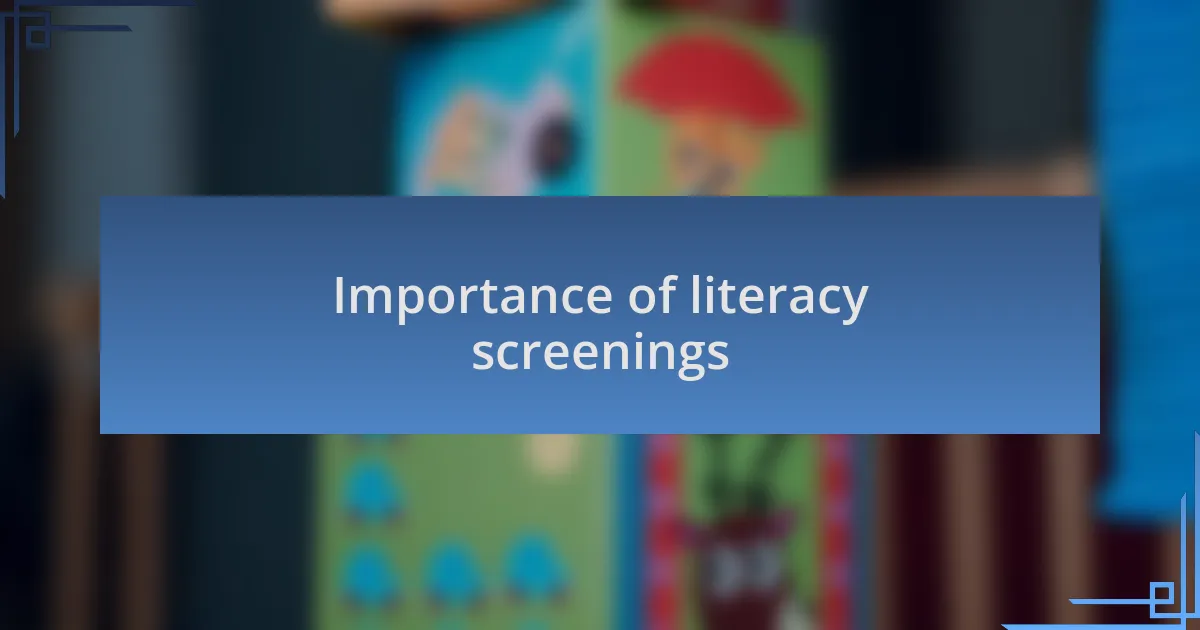
Importance of literacy screenings
Literacy screenings are crucial because they provide early insight into a child’s reading capacity, which can drastically change their educational trajectory. I still remember the moment a teacher shared a student’s screening results, revealing untapped potential. It’s amazing how a simple screening can open doors to tailored learning strategies that help children succeed.
These assessments not only highlight areas of difficulty but also allow for timely interventions. I once witnessed a child’s confidence blossom after receiving targeted support from the findings of their screening. Have you ever noticed how a little attention to a child’s specific struggles can lead to such remarkable progress?
Moreover, literacy screenings can foster a sense of collaboration between educators and parents. During my experience, I often found that discussing results with parents sparked valuable conversations about their child’s strengths and weaknesses. Doesn’t it feel empowering to be part of a shared goal, ensuring that every child receives the help they need to thrive?
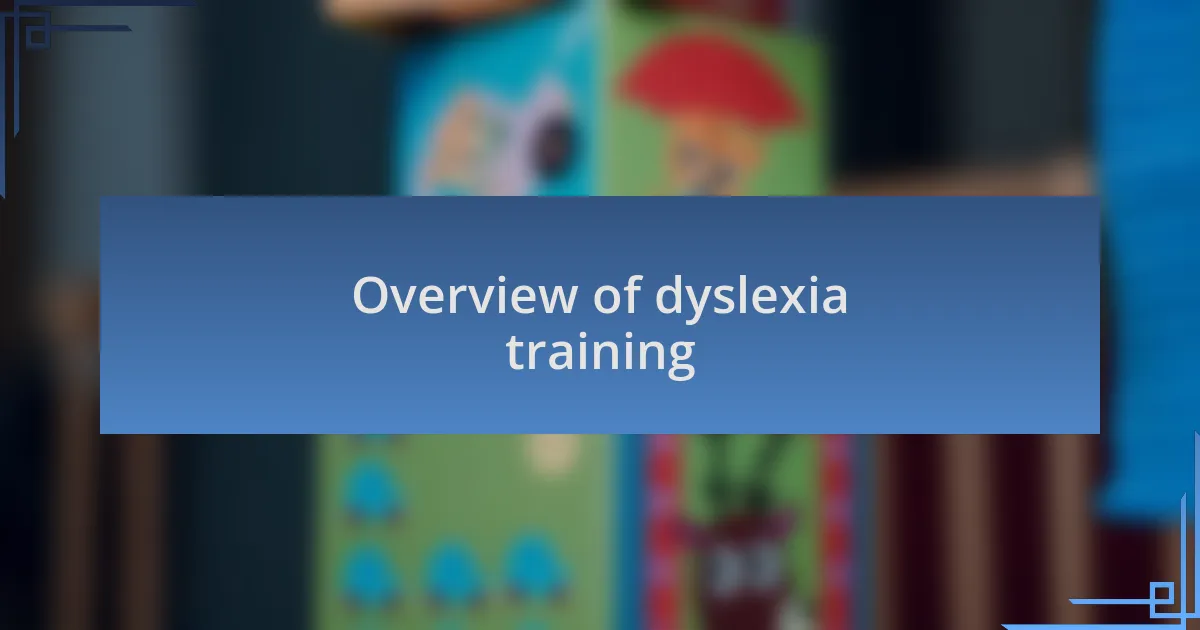
Overview of dyslexia training
Dyslexia training is a tailored approach that focuses on equipping educators and parents with the tools to support individuals with dyslexia. From my experience, these training sessions shed light on effective teaching strategies that cater to different learning styles. It was eye-opening to see how specific techniques, like multisensory instruction, could transform a struggling reader into a more confident learner.
One unforgettable moment for me was attending a dyslexia workshop where a passionate instructor demonstrated how to apply phonemic awareness through engaging activities. I could practically feel the energy in the room as participants began to grasp the impact these methods could have on a child’s literacy journey. Have you ever felt that spark of realization when a concept clicks? It’s a powerful reminder of why training is essential for those working with dyslexic students.
Moreover, dyslexia training fosters a deeper understanding of the emotional challenges faced by students. I remember discussing case studies that illustrated the frustration and anxiety many children with dyslexia experience. Seeing that connection made me reflect on my own approach in the classroom, and I couldn’t help but think, how can we create a more supportive atmosphere for these children?

My initial thoughts on screenings
The idea of literacy screenings first intrigued me, yet I had so many questions swirling in my mind. How accurately do these screenings reflect a child’s true abilities? When I witnessed my daughter go through her first screening, I felt a mix of hope and apprehension. I wanted to believe it would provide clarity for her struggles, but there was also that nagging worry about what the results might reveal.
During the screening process, I noticed just how pivotal the environment was. The tester’s patience and encouragement really shaped the experience. I remember watching my daughter visibly relax as she worked through the tasks, which made me think: could this supportive atmosphere help others feel more at ease during what can be such a daunting assessment?
Reflecting on my own experiences with literacy screenings, I realize it’s not just about the numbers or labels. I can still recall the relief that washed over me when we finally received a clearer picture of her challenges. It pushed me to ask, is it possible that these screenings could drive our understanding and empathy rather than just providing a diagnostic tool? This perspective shift is crucial in supporting students with dyslexia effectively.
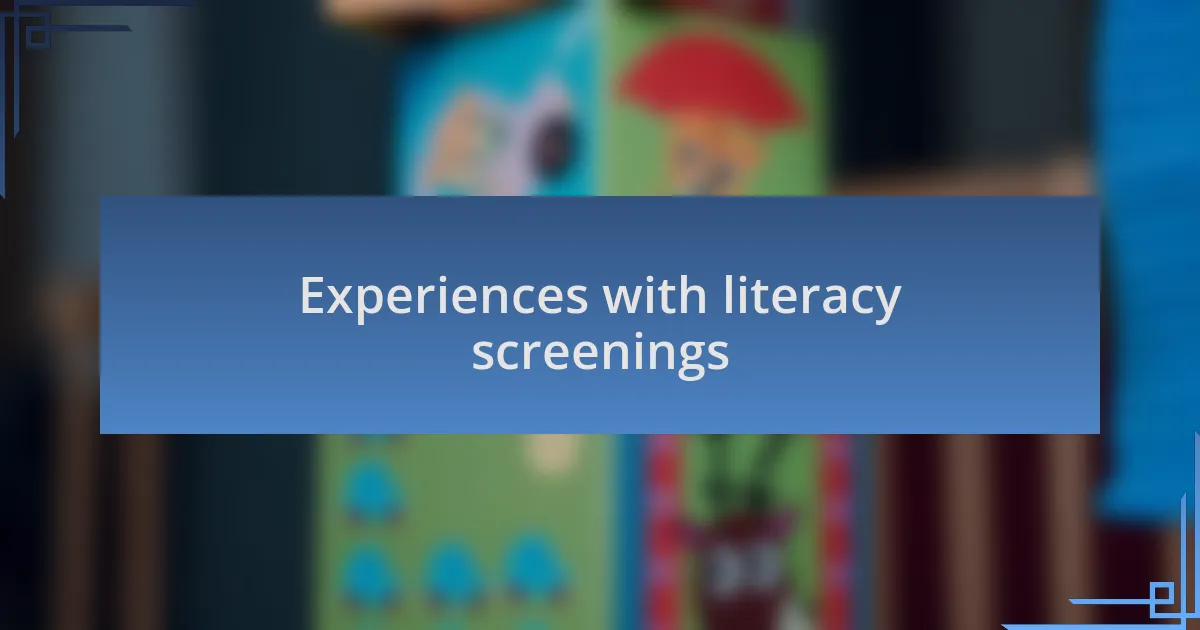
Experiences with literacy screenings
Experiences with literacy screenings are often filled with a range of emotions. I recall attending a screening session where my son seemed hesitant at first. As he tackled the reading tasks, I couldn’t help but notice how his confidence grew with each success. Isn’t it fascinating how a seemingly simple evaluation can unlock potential hidden beneath layers of anxiety?
There was a moment during one of the screenings when the tester provided positive feedback that completely shifted my son’s demeanor. I remember the way his eyes lit up – that spark of recognition that he could indeed succeed. It made me wonder if encouragement during assessments can have lasting effects beyond the immediate results. How often do we underestimate the importance of a nurturing approach in what might be perceived as a high-pressure situation?
Reflecting on these experiences, I see literacy screenings not just as assessments but as pivotal opportunities for growth. After those sessions, I felt a renewed sense of purpose in advocating for my child’s needs. It’s essential to recognize that screenings can serve as a gateway to deeper understanding, allowing us to build pathways of support for children with dyslexia. Have you ever considered the transformative power of simply adjusting the way we view these screenings?
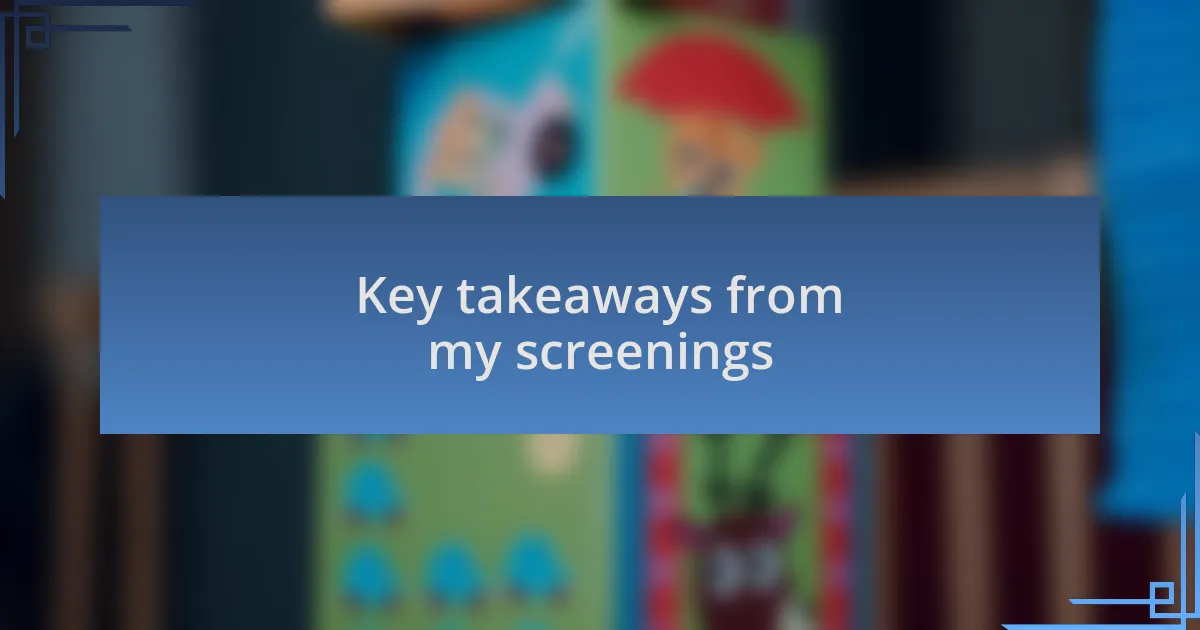
Key takeaways from my screenings
The first takeaway that resonates deeply with me is the importance of creating a comfortable environment. During one screening, I noticed how my son thrived once he felt safe and supported. It struck me that the right atmosphere can transform a daunting task into an engaging adventure. Have you seen how your surroundings affect your own performance?
Another key insight I gained is the power of tailored feedback. After a particularly challenging task, the tester offered specific suggestions for improvement rather than just noting what was wrong. I remember feeling a sense of relief as we discussed actionable steps together. Isn’t it amazing how constructive feedback not only clarifies expectations but also motivates the child to keep trying?
Finally, I found that collaboration among parents, teachers, and specialists is crucial for a successful outcome. At one screening, I had the opportunity to interact with educators who shared valuable strategies for home support. This exchange of ideas left me feeling empowered and optimistic about the journey ahead. How often do we take a moment to connect and discuss our children’s learning experiences with others?
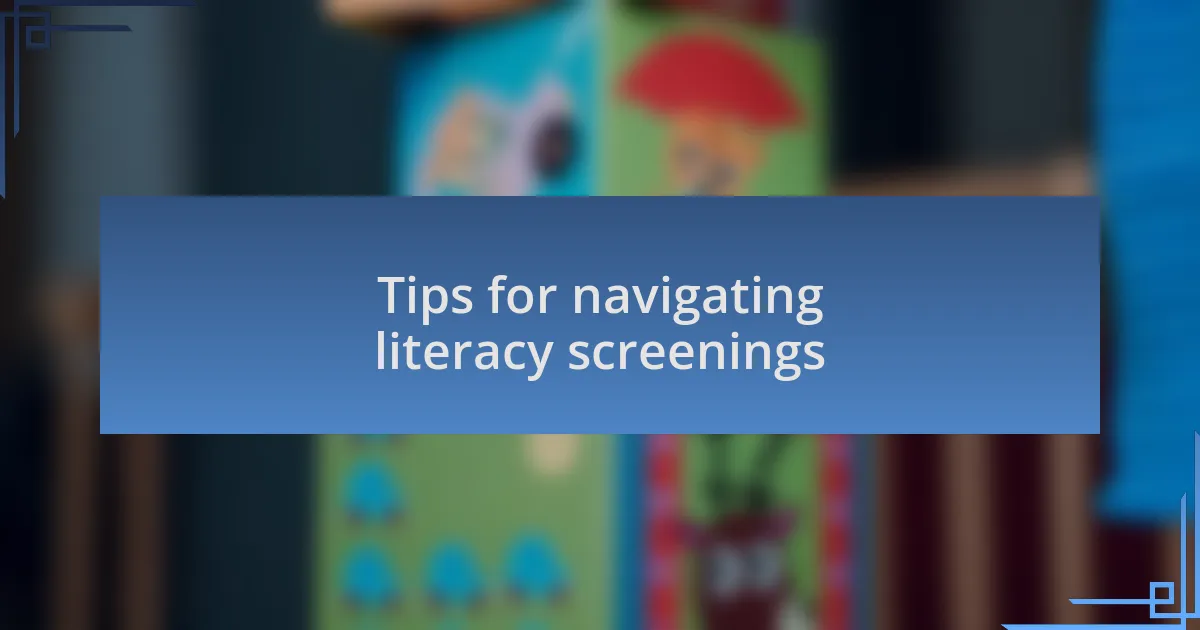
Tips for navigating literacy screenings
Navigating literacy screenings can be overwhelming, but I learned that preparation is key. I remember spending time with my son beforehand, going over the types of activities he might encounter. This practice not only eased his anxiety but also built his confidence. Have you ever noticed how familiarity with a task makes it feel less intimidating?
Another tip I found invaluable is to maintain open lines of communication with the screening professionals. During one session, I took the opportunity to ask questions and share my observations about my son’s strengths and challenges. This dialogue not only helped the tester understand him better, but it also gave me insights into strategies I could use at home. Have you ever thought about how this exchange can turn screenings into a collaborative learning experience?
Lastly, documenting the process can be incredibly beneficial. I began keeping a log of my son’s responses and the feedback received during each screening. This not only created a useful reference for future discussions but also allowed me to track his progress over time. Wouldn’t it be empowering to see how far he’s come in his literacy journey?